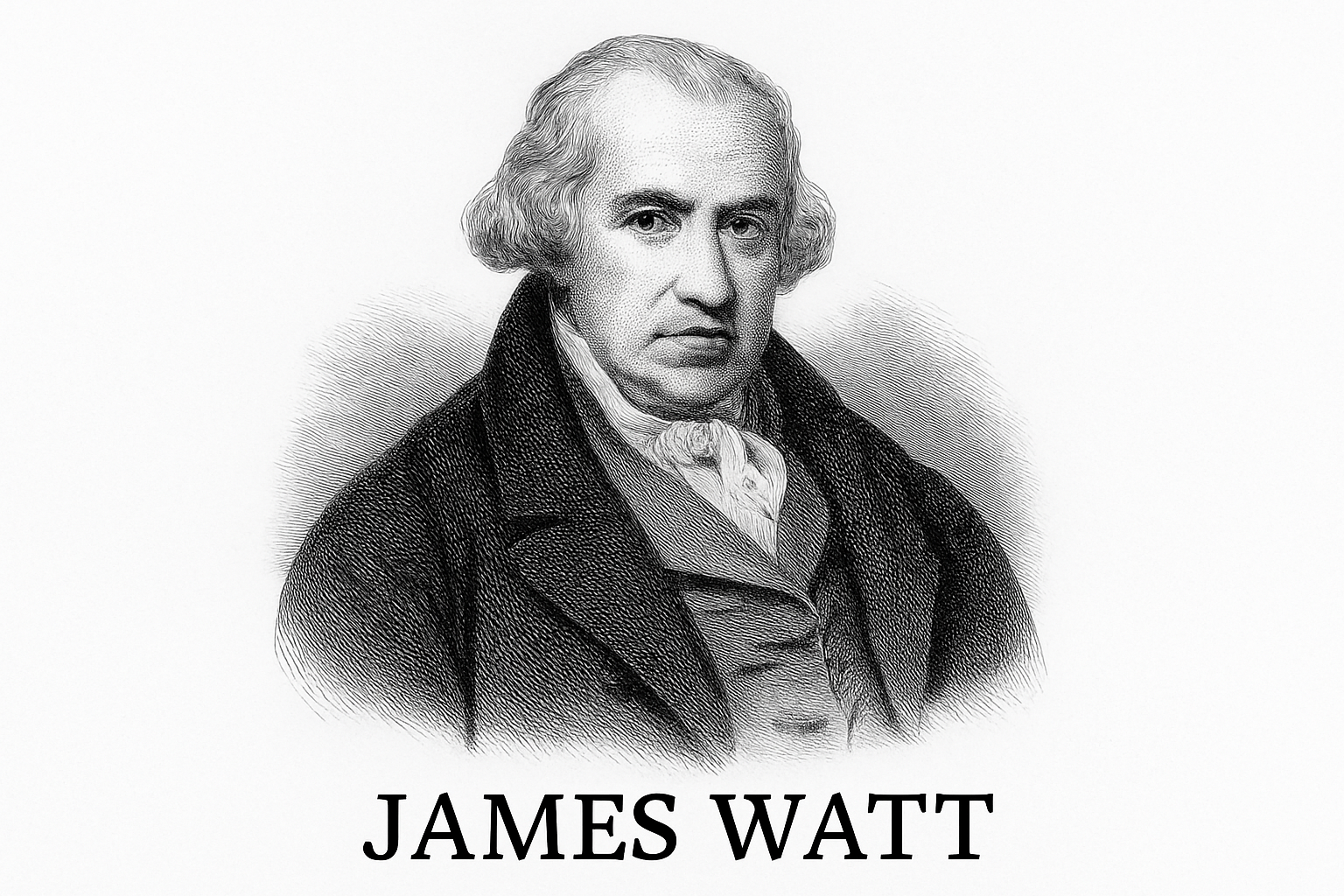James Watt: The Innovator Who Powered the Industrial Revolution
Revolutionising steam power, James Watt reshaped the world with invention and engineering brilliance

Introduction
James Watt is celebrated as one of the most influential inventors in history. Best known for his revolutionary improvements to the steam engine, his work became the driving force behind the Industrial Revolution. His legacy extends far beyond mechanical design; Watt’s ideas about energy and motion transformed not only industry but also the language of science, with the unit of power, the watt, named in his honour.
This article explores the life, education, key invention, invention date, family, and eventual age of death of James Watt — a man whose contributions continue to influence the world.
Early Life and Education
The Origins of a Genius
Born on January 19, 1736, in Greenock, Scotland, James Watt came from a family of tradesmen. His father was a skilled shipwright, while his mother was educated and encouraged learning. From an early age, Watt showed great skill in mathematics and mechanics, often disassembling and rebuilding objects for fun.
Education Pathway
Due to illness, Watt was home-schooled before attending Greenock Grammar School. His curiosity led him to Glasgow, where he became fascinated with instruments and engineering. He later trained in London as a mathematical instrument maker before returning to Glasgow. There, he worked at the University of Glasgow, where his exposure to academia and leading thinkers helped shape his future career.
Career Beginnings and Turning Point
The University Workshop
While working at the University of Glasgow, Watt was asked to repair a model of the Newcomen steam engine. This experience proved to be a turning point. Observing how inefficient the existing engine was, Watt began thinking of ways to improve it. He identified that much energy was wasted due to the heating and cooling of the same cylinder repeatedly.
The Game-Changing Invention
The Separate Condenser – A Revolutionary Idea
In 1765, James Watt invented the separate condenser, a device that greatly increased the efficiency of the steam engine. This marked the true beginning of his legendary status. The key to Watt’s steam engine was that it prevented the loss of heat by using a separate chamber to condense steam, saving both time and energy.
Invention Date and Patent
Although he developed the idea in 1765, the invention date officially recognised is January 5, 1769, when he was granted a patent. This marked the beginning of Watt’s journey as a globally recognised inventor.
Partnership with Matthew Boulton
Boulton & Watt
Watt lacked the funds to manufacture and market his engines. In 1775, he partnered with Matthew Boulton, a wealthy businessman. Together, they founded Boulton & Watt, a firm that produced and distributed steam engines across Britain and eventually Europe. Their partnership lasted for decades and helped install steam engines in mills, mines, and factories, fuelling industrial growth.
Innovations Beyond the Steam Engine
More Than Just One Invention
Although most known for the steam engine, Watt also invented several other mechanical devices:
-
The parallel motion system (1784)
-
The rotative engine with a sun-and-planet gear
-
The double-acting engine (1782)
-
The centrifugal governor to regulate speed (1788)
These devices not only enhanced the functionality of engines but also laid the groundwork for automation and factory systems.
Personal Life and Family
Marriages and Children
James Watt was married twice. His first wife, Margaret Miller, passed away in 1773. They had two surviving children, including James Watt Jr. He later married Ann MacGregor, with whom he had additional children, including Gregory Watt. His family supported and influenced his career throughout his life.
Age of Death and Final Years
Legacy and Age of Death
Watt retired from active business around 1800 but continued experimenting and inventing privately. He passed away on August 25, 1819, in Handsworth, Birmingham, at the age of death of 83. His contributions to engineering, physics, and industrial progress were unmatched in his time.
Enduring Impact
A Global Legacy
James Watt’s impact goes far beyond his lifetime. The watt, the international unit of power, was named in his honour in 1889. His engines powered the early Industrial Revolution, setting the foundation for the modern world. Today, his work is studied in schools and engineering colleges, and his influence is felt in every industry that relies on mechanical power.
Frequently Asked Questions (FAQ)
Q1: What was James Watt’s most important invention?
James Watt’s most important invention was the separate condenser, which made the steam engine vastly more efficient.
Q2: When did James Watt invent the steam engine?
He didn’t invent the steam engine from scratch but significantly improved it. The invention date of his key contribution — the separate condenser — is 1765, and he received a patent in 1769.
Q3: What was James Watt’s education background?
He was largely self-taught and trained as a mathematical instrument maker, later working at the University of Glasgow.
Q4: What was James Watt’s family like?
He had two wives and several children, including James Jr. and Gregory Watt. His family supported many of his ventures.
Q5: How old was James Watt when he died?
James Watt died at the age of 83 in 1819.
Conclusion
James Watt’s name is etched into the foundations of modern technology. Through his groundbreaking work on the steam engine, his ideas helped usher in the Industrial Revolution and reshape the economic landscape of the world. His background in education, his brilliant inventions, and his visionary mindset set him apart from his peers. The impact of his work is still evident today, and he remains a towering figure in science and engineering.
Let James Watt’s story be a reminder that even small improvements can lead to world-changing innovation.



